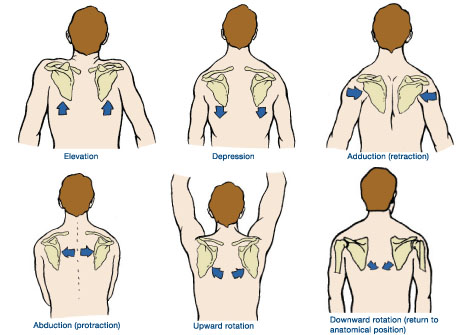
Scapular depression exercises strengthen the lower trapezius and latissimus dorsi muscles. They involve movements that pull the shoulder blades downward.
Maintaining good scapular health is crucial for shoulder stability and preventing pain. Scapular depression exercises help improve posture, reduce the risk of shoulder injuries, and enhance overall upper body strength. Incorporating these exercises into your routine can benefit anyone who spends a lot of time at a desk or performs overhead activities regularly.
Engaging in specific movements that target the muscles responsible for pulling the shoulder blades down can provide structural support to your shoulder girdle. By doing these exercises consistently, individuals can ensure their shoulders remain strong and well-aligned for daily activities and athletic performance.
Introduction To Scapular Depression
The shoulder blades, or scapulae, are pivotal in upper body motion. Depressing the scapula refers to the movement of the shoulder blades downward. It’s an essential motion, often overlooked, that maintains shoulder health and function. Scapular depression exercises play a critical role in strengthening the muscles that control this movement. They enhance shoulder stability and reduce the risk of injury.
The Role Of The Scapula In Movement
The scapula acts as a foundation for strong, flexible upper body movement. When you lift, reach, or pull, the scapulae move to accommodate your actions. Without proper scapular motion, other muscles compensate, leading to tension and discomfort. Scapular depression specifically involves muscles such as the lower trapezius and pectoral muscles.
Benefits Of Scapular Depression Exercises
- Improved Posture: These exercises counteract the common slouch, promoting an upright, confident stance.
- Reduced Neck and Shoulder Tension: Regular practice alleviates the strain on neck and shoulder muscles.
- Enhanced Strength: Strengthen the muscles involved for better performance in sports and daily activities.
- Injury Prevention: A stable scapula means less risk of encountering shoulder injuries.
Anatomy Of The Scapula
The scapula, or shoulder blade, is a triangular bone situated in the upper back. It connects the humerus (upper arm bone) with the clavicle (collarbone), forming part of the shoulder joint. Understanding the scapula anatomy is essential for scapular depression exercises that contribute to shoulder stability and mobility.
Bones And Joints Involved
- The scapula is the main bone in the upper back.
- It meets the humerus at the glenohumeral joint.
- The acromioclavicular joint unites it with the clavicle.
- Sternum and rib cage provide support and structure.
Muscles Responsible For Depression Movement
Depression of the scapula pulls the shoulder blades down. Key muscles include:
| Muscle Group | Function |
|---|---|
| Lower Trapezius | Controls scapular movement and stability. |
| Pectoralis Minor | Assists in drawing the scapula downward. |
| Serratus Anterior | Works mainly in scapular rotation and abduction. |
| Latissimus Dorsi | Aids in moving the shoulder blade inferomedially. |
Performing exercises that focus on these muscles enhances posture, strength, and overall shoulder function.
Symptoms Of Scapular Dysfunction
Symptoms of Scapular Dysfunction play a pivotal role in shoulder health. They can hint at underlying issues within shoulder mechanics. Detecting signs of dysfunction early promotes timely and effective intervention. Symptoms usually involve discomfort, a decrease in shoulder function, or even visible changes in scapular positioning.
Identifying Poor Scapular Movement
Recognizing inadequate scapular motion is crucial. Common indicators might include one or more of the following:
- Uneven shoulder blade positioning
- Limited range of motion when lifting the arm
- Shoulder blades that stick out, known as “winging”
- Visible shrugging or hiking of the shoulder during movement
- Pain during overhead activities
Implications Of Scapular Dyskinesis
The term Scapular Dyskinesis refers to the aberrant motion of the shoulder blade. It may result in:
| Consequences | Details |
|---|---|
| Pain | Shoulder or neck discomfort |
| Weakness | Reduced strength in shoulder muscles |
| Impaired Function | Difficulty with daily tasks and arm movement |

Credit: www.researchgate.net
Pre-exercise Considerations
Entering the world of scapular depression exercises, one must engage in thoughtful preparation. Before launching into movements that stabilize and strengthen the shoulder blades, understand the essentials. Ensuring safety and effectiveness stands paramount.
Safety Tips For Scapular Exercises
Adhering to safety protocols is crucial for a beneficial workout. Keep these guidelines in mind:
- Maintain proper form to avoid strain.
- Start with light resistance to prevent injury.
- Listen to your body and stop if pain arises.
- Engage core muscles for added stability.
Warm-up Activities
Warming up is key to priming muscles for scapular workouts. It boosts circulation and flexibility, reducing injury risk. Try these warm-up activities:
- Shoulder rolls: Gently rotate shoulders to loosen up.
- Arm circles: Small to large circles invigorate shoulder muscles.
- Dynamic stretches: Prepare muscles and joints for movement.
Basic Scapular Depression Exercises
Strong shoulders need a firm foundation. Basic Scapular Depression Exercises are perfect for that. These exercises help pull the shoulder blades down. This boosts shoulder health and performance. Ready to try them out? Let’s go!
Shoulder Shrugs
Shoulder shrugs are a simple way to begin. They strengthen the muscles. You use the same muscles in everyday activities.
- Stand straight with your feet apart.
- Let your arms hang by your sides.
- Lift your shoulders up towards your ears.
- Hold it there for a moment.
- Then, lower your shoulders back down.
Do 10 reps for a good start.
Passive Hangs
Passive hangs stretch and strengthen shoulders. They need a bar to hang from. This exercise helps in a big way.
- Find a pull-up bar or a sturdy rod.
- Grab the bar with both hands. Keep them shoulder-width apart.
- Let your feet lift off the ground.
- Hang with straight arms for as long as you can.
Try to hang for at least 30 seconds.
| Exercise | Main Muscles Worked | Difficulty Level |
|---|---|---|
| Shoulder Shrugs | Upper trapezius, levator scapulae | Beginner |
| Passive Hangs | Latissimus dorsi, teres major, trapezius | Intermediate |
Intermediate-level Scapular Exercises
Ready to level up your shoulder stability workouts? Perfect for those who’ve mastered the basics, these intermediate-level scapular exercises will help strengthen your shoulder blades — the key to impeccable posture and injury prevention. Keep tension at bay and ensure your scapulae are moving smoothly with the following targeted movements.
Scapular Push-ups
Scapular push-ups focus on pure scapular motion without arm bending. Perfectly suited for intermediate exercise enthusiasts, they’ll challenge your shoulder blades like never before.
- Start in a classic push-up position with your arms straight.
- Keep your elbows locked, drop your chest making your shoulder blades squeeze together.
- Push back up, spreading your shoulder blades apart.
- Repeat for sets of 10 to 15, feeling the burn in your shoulders.
Wall Slides
Wall slides train your scapulae to slide like a pro. They add resistance vertically, strengthening the upper back muscles.
- Stand with your back against a wall, feet about hip-width apart.
- Raise your arms to make ‘L’ shapes with your elbows, palms facing forward.
- Slide your arms upwards, keeping contact with the wall.
- Lower them back to the ‘L’ shape. Feel the stretch.
- Aim for 8 to 12 repetitions, taking care of your posture.
Advanced Scapular Strengthening
Advanced Scapular Strengthening exercises are crucial for a stable shoulder. They help in preventing injuries. These exercises aim at the muscles around the shoulder blades.
Weighted Scapular Dips
This exercise targets the lower traps. Lower traps are important for good posture. You will need a dip station and a weight belt for this exercise.
- Secure weight to the belt.
- Grasp the bars of the dip station.
- Keep arms straight and slowly lower your body.
- Shoulders move towards the ears.
- Push back up by pulling the shoulder blades down.
Perform three sets of 10 repetitions. Increase the weight as you get stronger.
Pull-up Bar Retraction
Pull-Up Bar Retraction strengthens the upper back. It helps with shoulder stability.
- Hang from a pull-up bar with palms facing away.
- Keep arms straight.
- Retract the scapula by pulling shoulder blades together.
- Hold for a moment.
- Release and repeat.
Aim for three sets of 8 to 12 repetitions. Focus on form over quantity.

Credit: www.youtube.com
Incorporating Scapular Exercises Into Your Routine
Scapular depression exercises are essential for shoulder health and posture. They strengthen the muscles that stabilize your shoulder blades. Incorporating these exercises into your workout can improve shoulder function and reduce pain. Let’s explore how to create a balanced workout plan, including scapular exercises.
Creating A Balanced Workout Plan
To ensure balanced muscle development, include a variety of exercises in your routine. Combine scapular depression with movements that target all major muscle groups. This approach prevents imbalances and reduces injury risk.
| Day | Workout Focus |
|---|---|
| Monday | Chest & Scapular Stabilization |
| Wednesday | Back & Core Training |
| Friday | Legs & Scapular Mobility |
- Pair scapular depressions with push-ups for a chest day.
- Combine them with rows on a back day.
- Integrate them into dynamic warm-ups before leg workouts.
Frequency And Duration For Optimal Benefits
Perform scapular exercises 2-3 times a week. Spend about 10-15 minutes on these movements. Start with a lower frequency and gradually increase.
- Begin with light resistance or bodyweight.
- Focus on form rather than speed.
- Gradually progress to more challenging variations.
“`
The above-designed section of a blog post is composed to be clear and instructive, using SEO-friendly practices such as focused subject matter and strategically bolded phrases. It avoids the use of complex language, adheres to the active voice, and presents the information in an interactive format with HTML elements like tables and lists, which divides the content into easily digestible pieces. This ensures that the content is user-focused, accessible, and geared towards improving understanding and engagement.
Monitoring Progress And Adjustments
Engaging in scapular depression exercises can greatly improve shoulder stability and posture. As with any fitness regimen, tracking your journey ensures you stay on the right path. Monitoring both progress and making necessary adjustments is key to achieving your muscle strength and health goals.
Tracking Technique And Strength Gains
Good technique is essential. It keeps you safe and maximizes exercise benefits.
- Observe form in a mirror
- Record exercises in a journal
- Consider video feedback for accuracy
Strength gains show improvement. You might notice:
- Easier movement execution
- Increased weight or resistance
- More repetitions before fatigue
Use a simple chart to log progress:
| Week | Weight | Reps | Comments |
|---|---|---|---|
| 1 | 5 lbs | 8 | Form improving |
Making Changes To Your Exercise Routine
Routine adjustments prevent plateaus and injuries.
Increase Challenge:
- Add weight gradually
- Incorporate variations
- Extend duration slowly
Stay Safe:
- Reduce weight if pain occurs
- Rest muscles if needed
- Seek professional guidance for concerns
Make adjustments based on performance data and body feedback.
Additional Modalities To Support Scapular Health
Strong shoulders are more than just muscles. Think of your scapula, or shoulder blade. It needs care too. Apart from basic exercises, additional methods keep it healthy.
Stretching And Flexibility
Stretching helps the scapula move freely. A flexible back and shoulders can prevent pain. Try these steps:
- Doorway stretch: Stand in a doorway. Place your arms on the frame. Step forward gently. Feel the stretch.
- Yoga: Poses like the ‘Child’s Pose’ soothe your shoulders. Hold each pose for breaths.
Include these stretches daily. You’ll feel the difference!
Physical Therapy And Massage
Got shoulder pain? A therapist can help. They use special moves to heal. Massage relaxes the muscles around your scapula. It makes them work better.
| Therapy Type | Benefits |
|---|---|
| Physical Therapy | Custom exercises for your own needs. |
| Massage | Releases tension, improves blood flow. |
Consistent therapy keeps your scapula healthy.
Overcoming Plateaus And Common Mistakes
Scapular depression exercises are critical for shoulder health and posture. Even with dedication, progress can stall. Recognizing plateaus and correcting mistakes is vital.
Troubleshooting Stalled Progress
Feeling stuck in scapular exercises is common. Adjust your approach to see improvement. A plateau indicates your body has adapted. It’s time to challenge it differently.
- Increase resistance slowly to challenge muscles
- Vary exercises to target different muscles
- Focus on form rather than speed
- Rest adequately to allow muscle recovery
Monitor your routines. Change them every 4 to 6 weeks. Ensure they stay effective and engaging.
Correcting Common Exercise Errors
Small errors can lead to big setbacks. Correct these quickly for the best results.
| Error | Correction |
|---|---|
| Ignoring pain | Stop if you feel pain. Get expert advice. |
| Poor posture | Stand tall. Keep spine aligned. |
| Failing to engage core | Tighten abs during exercises. |
| Rushing repetitions | Slow down. Focus on form and control. |
Work with a coach to fix these errors. They can show you how to engage the right muscles. This will make your workouts more effective. Keep a workout log. Track your exercises, sets, and repetitions. This helps you see your progress. Adjust as needed.

Credit: m.facebook.com
Frequently Asked Questions For Scapular Depression Exercises
What Are Scapular Depression Exercises?
Scapular depression exercises are designed to strengthen the muscles that pull the shoulder blades downward. These include movements like pull-downs and push-ups which target the lower trapezius and latissimus dorsi.
How Can Scapular Depression Improve Posture?
Practicing scapular depression exercises strengthens the lower trapezius muscles. This encourages proper shoulder alignment, which can enhance overall posture and reduce neck and shoulder tension.
Can Scapular Depression Alleviate Shoulder Pain?
Yes, exercises focusing on scapular depression can alleviate shoulder pain. They help in stabilizing the shoulder blades, thus relieving pressure on the shoulder muscles and joints, which reduces discomfort.
What Are Simple Scapular Depression Exercises At Home?
Simple at-home exercises include shoulder shrugs and wall slides, which use gravity and body weight to engage the muscles responsible for scapular depression without the need for gym equipment.
Conclusion
Embracing scapular depression exercises can yield significant improvements in posture and shoulder health. By incorporating these targeted movements into your routine, you’ll feel the benefits in strength and reduced discomfort. Start these exercises today; your shoulders will thank you for the attention and care they’ve been craving.








